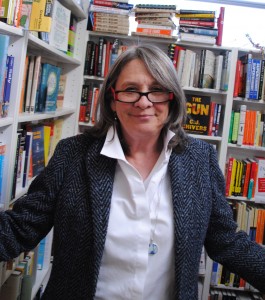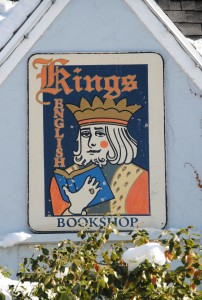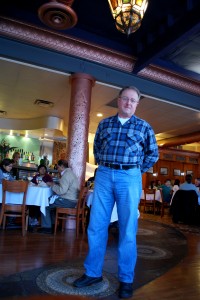King’s English Bookshop
by James Gunter
What was once a sleepy corner of Sugar House is now a thriving part of the community.
When the King’s English bookshop opened in 1977, the 15th and 15th area was a strip of half-empty storefronts and dying businesses surrounded by residential homes.
Salt Lake Drug once dominated the eastern side of the block, and entering it felt like taking a trip back to 1954 for some caster oil and sock-garters. The Western side was dotted with small businesses like a laundromat and a dry cleaner, where local women would have their furs cleaned and stored.

But the once sleepy corner is now thriving.
“When we first started here, people thought we were crazy,” says Betsy Burton, founder and owner of the King’s English. She had originally rented an office across the street so she could write a novel and had asked a writer friend to join her. “We thought, wouldn’t it be nice to start a little bookshop where we could serve coffee and have places for people to sit and read.” And so, in 1977, the King’s English was born.
It didn’t much matter to her at the time that the area was aging and most of the businesses weren’t doing well; she had a commitment to running a great locally owned business. Today, many of those old businesses have disappeared and the storefronts have changed, bringing in chains like Starbucks and Einstein’s bagels.
When asked what he thinks about chains moving into the area, Don Steward, the owner of The Dog Show, at 15th and 15th for over 20 years, says he doesn’t mind. He says some people complain about the chains moving into an area that has historically been dominated by local businesses, but overall, it’s been good for business. He says he gets more foot traffic and more people driving by, seeing his shop, which is never a bad thing.
Jacob Dauwalder, a shift manager at Einstein’s, says he enjoys working in the area as well. “I’ve worked at a lot of businesses in Sugarhouse,” he says. “But this is the best place I’ve worked. We get a lot of people from the neighborhood coming in. It’s very easygoing.”
“There is a cycle to these things,” says Burton. “When you have successful local businesses, the chains pick up on it, and they move into the area hoping to capitalize on the location.” When they move in, the landlords realize that chains are willing to pay much higher prices, so they tend to raise the rent on the other businesses in the area. Burton says this usually pushes local businesses out, “but chains usually have a shelf life of about 10 years.” When the chains die, and the rent decreases again, local businesses have a chance to move back into the area and revitalize it.

But that cycle has come with challenges of its own. Steward has seen some tension between local businesses and the surrounding neighborhood. Increased traffic and parking problems are a perennial complaint, and some residents have gotten extremely passionate about their opposition to the 15th and 15th businesses.
On the other hand, Burton says she’s never had any real problems with the surrounding residents. “It’s important to maintain a balance,” she says about areas that attempt to seamlessly mix residential housing and commercial businesses like 15th and 15th. “Community means everything. I didn’t realize how important community was when I started.” She’s learned that businesses and residents share a type of symbiotic relationship where residents enjoy easy access to local services, and businesses benefit from the local foot traffic. “If either one disappeared, it would leave a huge hole in the community,” she says.
But that’s not going to happen anytime soon. Through the years, with zoning issues and resident complaints, the 15th and 15th area has served as

a laboratory for proving that walkable, sustainable, mixed communities can cohabitate. “The city sees this area as a sort of nirvana for the way that local businesses and neighborhoods can co-exist in a mutually beneficial relationship,” says Steward. And that’s not something the city wants to lose anytime soon.
When asked what he thinks about chains moving into the area, Don Steward, the owner of The Dog Show, at 15th and 15th for over 20 years, says he doesn’t mind. He says some people complain about the chains moving into an area that has historically been dominated by local businesses, but overall, it’s been good for business. He says he gets more foot traffic and more people driving by, seeing his shop, which is never a bad thing.
Despite the chains three of Salt Lake City’s best local restaurants are located in the 15th and 15th area.
Ali Sabbah launched Mazza at 15th and eventually found a very receptive clientelle to his Middle Eastern and Lebanese cuisine.
While the word “bistro” is heavily overused, Paris Bistro and Zinc bar can easily claim the title of Utah’s most authentic parisian style bistro.
Also nestled away on 15th is Fresco Italian cafe which features local ingredients and fine dining. Fresco has won numerous awards for their great food.
Also, Tony Caputos has adding a small grocery store offering fresh breads and a huge assortment of imported olive oils, and Italian gourmet cooking ingredients.
Addition from the editor:
The lesson that Utah city planners and municipality leaders could learn from 15th and 15th is that neighborhoods should be designed for pedestrians instead of cars. Parking at 15th and 15th is scarce but the businesses there are thriving because people can easily find other options for getting there, such as walking or biking.
.
.
.
.

